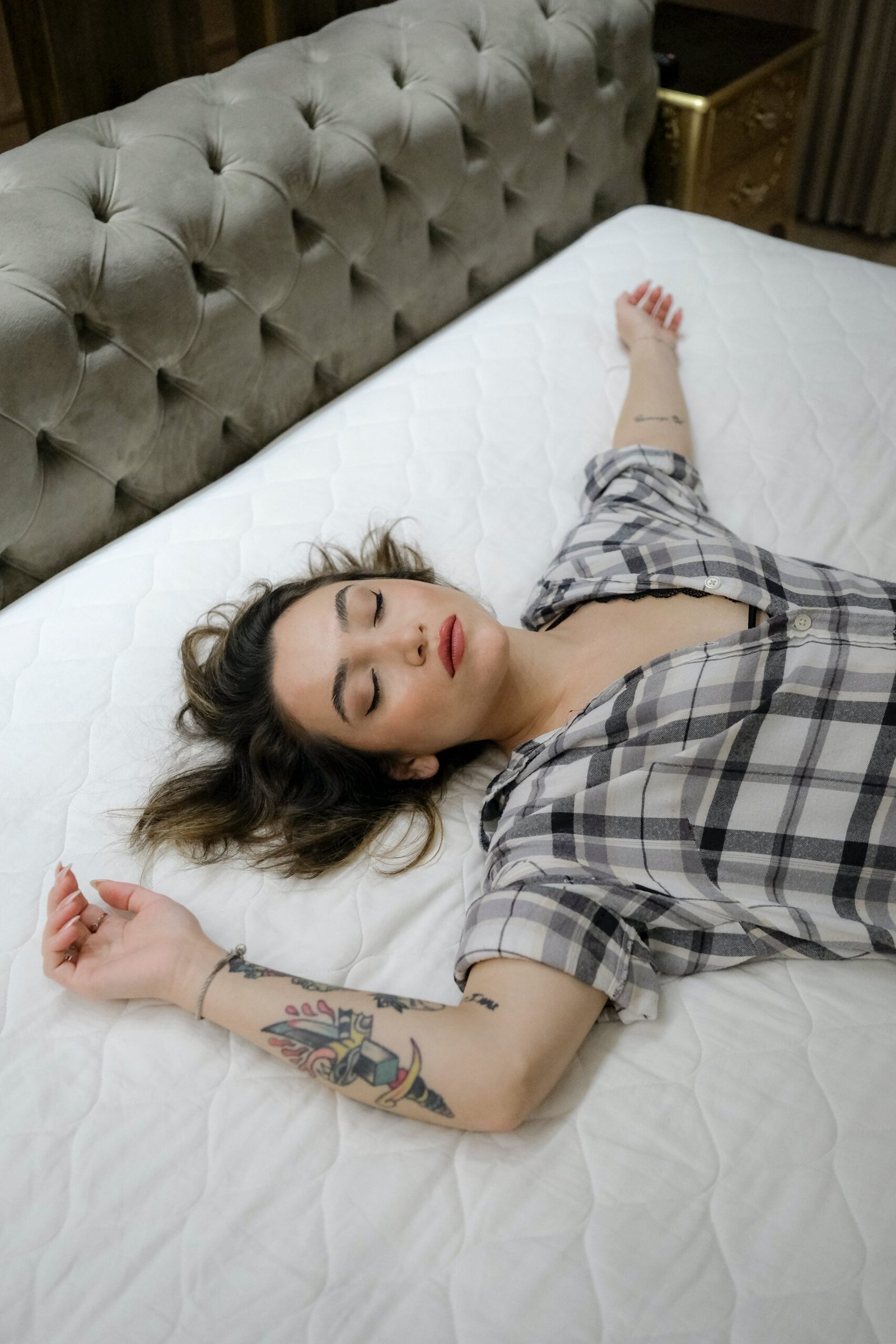
From time to time, we all wake up with a sore shoulder that seemingly came out of nowhere. Whether it’s caused by sleeping in an awkward position or having an uncomfortable mattress, this nagging pain can really put a damper on your day. But fret not, because in this article, we’ll share some simple and effective techniques to help you relieve shoulder soreness after sleeping. So, say goodbye to those mornings filled with discomfort and start waking up refreshed and ready to take on the day!

1. Understanding the Causes of Shoulder Soreness after Sleeping
We’ve all experienced waking up with shoulder soreness after a night’s rest, and it can really disrupt our day. Understanding the causes of this discomfort is the first step towards finding relief.
1.1 Sleep Position
The position in which you sleep plays a significant role in shoulder soreness. Sleeping on your side or stomach can put pressure on your shoulder joints, causing them to become sore and painful. On the other hand, sleeping on your back allows for a more neutral alignment, reducing the strain on your shoulders.
1.2 Prolonged Shoulder Pressure
Another common cause of shoulder soreness after sleeping is prolonged pressure on the shoulder. This can occur when your arm is placed under your body or trapped between your body and the mattress for an extended period. The sustained pressure can lead to discomfort and inflammation in the shoulder joint.
1.3 Muscular Imbalances
Muscular imbalances in the shoulder area can also contribute to soreness after sleeping. Imbalances can develop due to poor posture, repetitive activities, or a lack of strength and flexibility in the surrounding muscles. These imbalances put excessive strain on certain muscles and joints, resulting in shoulder soreness.
1.4 Inadequate Pillow Support
The type and quality of your pillow can have a significant impact on shoulder soreness. If your pillow doesn’t provide adequate support to your head and neck, it can cause you to adopt poor sleeping positions, leading to shoulder discomfort. Additionally, an old or worn-out pillow may no longer provide the necessary cushioning for your shoulders, exacerbating soreness.
1.5 Rotator Cuff Injuries
Rotator cuff injuries are a common cause of shoulder pain, and they can also be aggravated during sleep. Sleeping in positions that place strain on the rotator cuff, such as sleeping on your side with your arm extended overhead, can worsen existing injuries or lead to new ones, resulting in shoulder soreness.
2. Remedies to Alleviate Shoulder Soreness
While shoulder soreness can be bothersome, there are several effective remedies that can help alleviate the discomfort and promote healing.
2.1 Adjusting Sleeping Positions
One of the easiest ways to relieve shoulder soreness after sleeping is to adjust your sleeping position. Sleeping on your back with a supportive pillow can help maintain proper alignment and reduce strain on your shoulders. If you prefer sleeping on your side, placing a pillow between your arms and legs can provide additional support and alignment.
2.2 Stretching and Strengthening Exercises
Stretching and strengthening exercises targeted towards the shoulder can help alleviate soreness and prevent future discomfort. Shoulder rolls, pendulum stretches, doorway stretches, shoulder blade squeezes, and posterior capsule stretches are all effective exercises that can improve flexibility and strength in the shoulder muscles.
2.3 Heat or Cold Therapy
Applying heat or cold therapy to your sore shoulder can help reduce inflammation and provide pain relief. Applying a warm towel or using a heating pad for 15-20 minutes can help relax the muscles and improve blood flow. Conversely, using a cold pack or ice wrapped in a cloth for 15-20 minutes can help numb the area and reduce swelling.
2.4 Massage and Self-Myofascial Release
Massage and self-myofascial release techniques can help relieve tension and tightness in the shoulder muscles, promoting pain relief and relaxation. Consider scheduling a professional massage or learn self-massage techniques using your hands, a tennis ball, or a foam roller. These techniques can help release muscle knots and improve blood flow to the shoulder area.
2.5 Using Supportive Pillows or Sleep Aids
Investing in supportive pillows or sleep aids specially designed for shoulder support can significantly alleviate shoulder soreness. Ergonomic pillows, shoulder pillows, body pillows, and sleep aids such as adjustable beds or mattress toppers can provide the necessary cushioning and alignment to reduce shoulder discomfort during sleep.

3. Adjusting Sleeping Positions
The sleep position you choose can make a notable difference in alleviating shoulder soreness. Let’s explore the sleep positions that are most beneficial for your shoulder health.
3.1 Sleeping on your Back
Sleeping on your back is generally the best position for reducing shoulder soreness. It allows for a neutral alignment of the shoulder joint, relieving strain and pressure. To enhance comfort, consider using a pillow under your knees to maintain the natural curve of your lower back.
3.2 Sleeping on your Side with a Pillow
If you prefer sleeping on your side, it’s essential to use a pillow that properly supports your head and neck, while also maintaining spinal alignment. Additionally, placing a pillow between your arms and legs can help reduce strain on your shoulders and promote proper posture.
3.3 Avoiding Sleeping on your Stomach
Sleeping on your stomach is generally the least recommended position for shoulder health. It can lead to shoulder rotation and extension, putting strain on the joints and muscles. If you find it challenging to avoid sleeping on your stomach, try incorporating pillows strategically to discourage this position.
4. Stretching and Strengthening Exercises
Stretching and strengthening exercises for your shoulder can help relieve soreness and improve the overall health of the joint. Let’s explore some effective exercises that target the shoulder muscles.
4.1 Shoulder Rolls
Shoulder rolls are simple yet effective exercises to release tension and promote flexibility. Start by sitting or standing with your arms relaxed at your sides. Slowly roll your shoulders in a circular motion, moving forward, up, back, and down. Repeat this motion for 10-15 rotations, then reverse the direction.
4.2 Pendulum Stretch
The pendulum stretch targets the muscles and tendons in the shoulder joint, promoting flexibility and relieving soreness. Stand beside a table or chair and lean forward, supporting your non-affected arm on the surface. Allow your affected arm to hang freely, and gently sway it in a small circular motion, forward and backward, and side to side. Perform this exercise for 1-2 minutes on each arm.
4.3 Doorway Stretch
The doorway stretch is a great exercise for stretching the chest and shoulder muscles, alleviating soreness and improving flexibility. Stand facing a doorway and place your hands on the doorframe at shoulder height. Step forward with one foot, slightly leaning your body into the doorway. You should feel a stretch in the front of your chest and shoulders. Hold for 30 seconds and repeat for each side.
4.4 Shoulder Blade Squeezes
Shoulder blade squeezes target the muscles between the shoulder blades, promoting strength and stability in the shoulder joints. Sit or stand with your arms relaxed at your sides. Gently squeeze your shoulder blades together, imagining that you are holding a pencil between them. Hold the squeeze for 5-10 seconds, then release. Repeat this exercise for 10-15 repetitions.
4.5 Posterior Capsule Stretch
The posterior capsule stretch focuses on improving shoulder flexibility and reducing stiffness. Stand with your unaffected arm raised to eye level and your affected arm behind your lower back. Use your unaffected arm to gently pull the affected arm across your body, feeling a stretch in the back of your shoulder. Hold this stretch for 30 seconds and repeat on each side.

5. Heat or Cold Therapy
Applying heat or cold therapy to your sore shoulder can provide soothing relief and aid in the healing process. Let’s explore the different methods of using heat and cold therapy.
5.1 Applying Heat
Applying heat to your shoulder can help relax the muscles, increase blood flow, and reduce pain. You can use a warm towel, a heating pad, or take a warm shower to apply heat to the affected area. Remember to use a moderate temperature and limit the application to 15-20 minutes at a time.
5.2 Using Cold Packs
Using cold packs on your shoulder can help reduce inflammation, numb the area, and provide pain relief. Wrap a cold pack or ice in a cloth and apply it to the sore shoulder for 15-20 minutes. Ensure that you never apply ice directly to the skin, as it can cause ice burns.
5.3 Contrast Therapy
Contrast therapy involves alternating between heat and cold therapy to promote circulation and reduce inflammation. Start by applying heat to your shoulder for 10 minutes, followed by 5 minutes of cold therapy. Repeat this cycle two to three times, always ending with cold therapy. Contrast therapy can enhance the benefits of individual heat and cold treatments.
6. Massage and Self-Myofascial Release
Massage and self-myofascial release techniques can help alleviate tension and promote healing in the shoulder muscles. Let’s explore these methods in detail.
6.1 Professional Massage
Scheduling a professional massage with a licensed therapist can be highly beneficial for relieving shoulder soreness. A skilled massage therapist can target specific areas of tension, use various techniques to release muscle knots, and enhance blood circulation. Communicate your specific concerns to the therapist, ensuring they focus on your shoulder area.
6.2 Self-Massage Techniques
If professional massages aren’t readily available, you can also perform self-massage techniques at home. Start by using your hands to apply gentle pressure and knead the muscles in your shoulders. You can also use a tennis ball or a foam roller to target specific areas of tension. Experiment with different techniques and find what works best for you.
6.3 Foam Rolling
Foam rolling is an effective self-myofascial release technique that can help reduce tightness and promote muscle relaxation in the shoulder area. Lie on your side with a foam roller placed under your affected shoulder. Use your body weight to roll gently back and forth along the muscle groups of the shoulder. Allow the foam roller to target any areas of tension or discomfort.
7. Using Supportive Pillows or Sleep Aids
Investing in supportive pillows or sleep aids can greatly alleviate shoulder soreness and promote a comfortable sleep environment. Let’s explore some options to consider.
7.1 Ergonomic Pillows
Ergonomic pillows are designed to provide optimal support to your head, neck, and shoulders during sleep. They are often made with memory foam or other contouring materials that help maintain proper alignment. Look for a pillow specifically designed for side or back sleepers to ensure maximum comfort and support.
7.2 Shoulder Pillows
Shoulder pillows are specially designed to provide additional support to the shoulder area while you sleep. These pillows often have a cut-out or indentation that accommodates the shoulder, allowing for proper alignment and relieving pressure on the joint. They can be particularly beneficial for those with pre-existing shoulder conditions.
7.3 Body Pillows
Body pillows can be a helpful addition to your sleep routine, especially if you prefer sleeping on your side. These long, full-length pillows provide support to your entire body, including your shoulders. By hugging the body pillow, you can maintain spinal alignment and reduce strain on the shoulders.
7.4 Sleep Aids
In addition to pillows, there are sleep aids available that can help improve your sleep environment and alleviate shoulder soreness. Adjustable beds allow you to find the most comfortable position for your shoulders and back, providing optimal support. Mattress toppers made with pressure-relieving materials can also help distribute weight evenly, reducing pressure on the shoulders.
8. Making Lifestyle Modifications
Certain lifestyle modifications can also contribute to reducing shoulder soreness after sleeping. Let’s explore some changes you can make to promote shoulder health.
8.1 Maintaining Proper Posture
Maintaining proper posture throughout the day can significantly impact your shoulder health. Be mindful of your posture when sitting, standing, and performing daily activities. Avoid slouching, and aim to keep your shoulders relaxed and aligned. Incorporating regular posture checks can prevent the development of muscular imbalances that contribute to shoulder soreness.
8.2 Taking Breaks from Repetitive Activities
Engaging in repetitive activities, such as typing or lifting heavy objects, can place strain on your shoulders. Take regular breaks to rest and stretch your shoulders, allowing them to recover from the repetitive movements. Incorporate stretching exercises into your routine to counteract the effects of repetitive tasks.
8.3 Avoiding Heavy Lifting
Heavy lifting can put excessive strain on your shoulders and increase the risk of injury. Whenever possible, use proper lifting techniques or ask for assistance when lifting heavy objects. Distribute the weight evenly between both arms and engage your legs and core muscles to support the lift.
8.4 Managing Stress Levels
High levels of stress can contribute to muscle tension and exacerbate shoulder soreness. Find healthy ways to manage your stress, such as practicing relaxation techniques, engaging in hobbies, or seeking support from friends and family. By reducing stress, you can promote overall muscle relaxation and alleviate shoulder discomfort.
9. When to Seek Medical Attention
While most cases of shoulder soreness after sleeping can be relieved through self-care measures, certain situations may warrant medical attention. Let’s explore when it’s necessary to seek professional help.
9.1 Persistent or Intense Pain
If your shoulder soreness persists or becomes increasingly intense, it may indicate an underlying issue that requires medical evaluation. Pain that doesn’t improve with self-care measures, such as stretching or heat therapy, should be assessed by a healthcare professional.
9.2 Limited Range of Motion
If you experience a limited range of motion in your shoulder, such as difficulty lifting your arm or reaching overhead, it may indicate a more significant problem. These limitations can be due to muscle imbalances, rotator cuff injuries, or other conditions that merit a medical evaluation.
9.3 Signs of Inflammation or Infection
Swelling, redness, warmth, or signs of infection such as fever or significant tenderness require immediate medical attention. These signs may indicate a more severe underlying condition, such as bursitis or an infection within the shoulder joint.
9.4 Chronic Shoulder Issues
If you have a history of chronic shoulder issues, such as osteoarthritis or recurring shoulder dislocations, it’s important to consult with a healthcare professional. They can provide personalized recommendations and treatment options to manage and prevent future shoulder soreness.
10. Preventive Measures to Avoid Shoulder Soreness
Taking preventive measures is crucial for avoiding shoulder soreness after sleeping. Implement these measures into your daily routine to promote shoulder health.
10.1 Choosing the Right Pillow
Invest in a pillow that provides optimal support for your head, neck, and shoulders. Consider factors such as pillow material, loft height, and firmness. Testing different pillows or seeking guidance from a healthcare professional can help you find the right pillow for your specific needs.
10.2 Engaging in Regular Exercise
Regular exercise can strengthen the muscles surrounding the shoulder joint, improving stability and reducing the risk of soreness and injuries. Include exercises that target the shoulder muscles in your workout routine, such as shoulder presses, lateral raises, and rows. However, always consult with a healthcare professional before starting a new exercise program.
10.3 Practicing Good Sleep Hygiene
Practicing good sleep hygiene involves adopting healthy habits that promote quality sleep. Maintain a consistent sleep schedule, create a relaxing bedtime routine, and create a sleep environment that is cool, dark, and quiet. By prioritizing quality sleep, you can optimize muscle recovery and reduce the likelihood of waking up with shoulder soreness.
10.4 Maintaining a Healthy Weight
Excess weight can put additional strain on your shoulders and joints, increasing the risk of soreness and injuries. Maintain a healthy weight through a balanced diet and regular exercise, which can reduce unnecessary pressure on the shoulder joints and promote overall shoulder health.
10.5 Listening to Your Body
Lastly, listen to your body’s cues and respond accordingly. Take breaks when you feel discomfort or strain in your shoulders, modify your activities or sleep positions if they cause soreness, and seek professional help if you need it. By being attuned to your body’s needs, you can prevent and address shoulder soreness effectively.
In conclusion, shoulder soreness after sleeping can be caused by various factors such as sleep position, prolonged pressure, muscular imbalances, inadequate pillow support, or pre-existing injuries. Fortunately, there are several remedies available to alleviate shoulder soreness, including adjusting sleeping positions, incorporating stretching and strengthening exercises, using heat or cold therapy, practicing massage and self-myofascial release techniques, and using supportive pillows or sleep aids. Making lifestyle modifications, knowing when to seek medical attention, and adopting preventive measures can also help prevent shoulder soreness in the long run. By taking care of your shoulders and prioritizing their health, you can wake up feeling refreshed and ready to tackle the day without any lingering discomfort.







